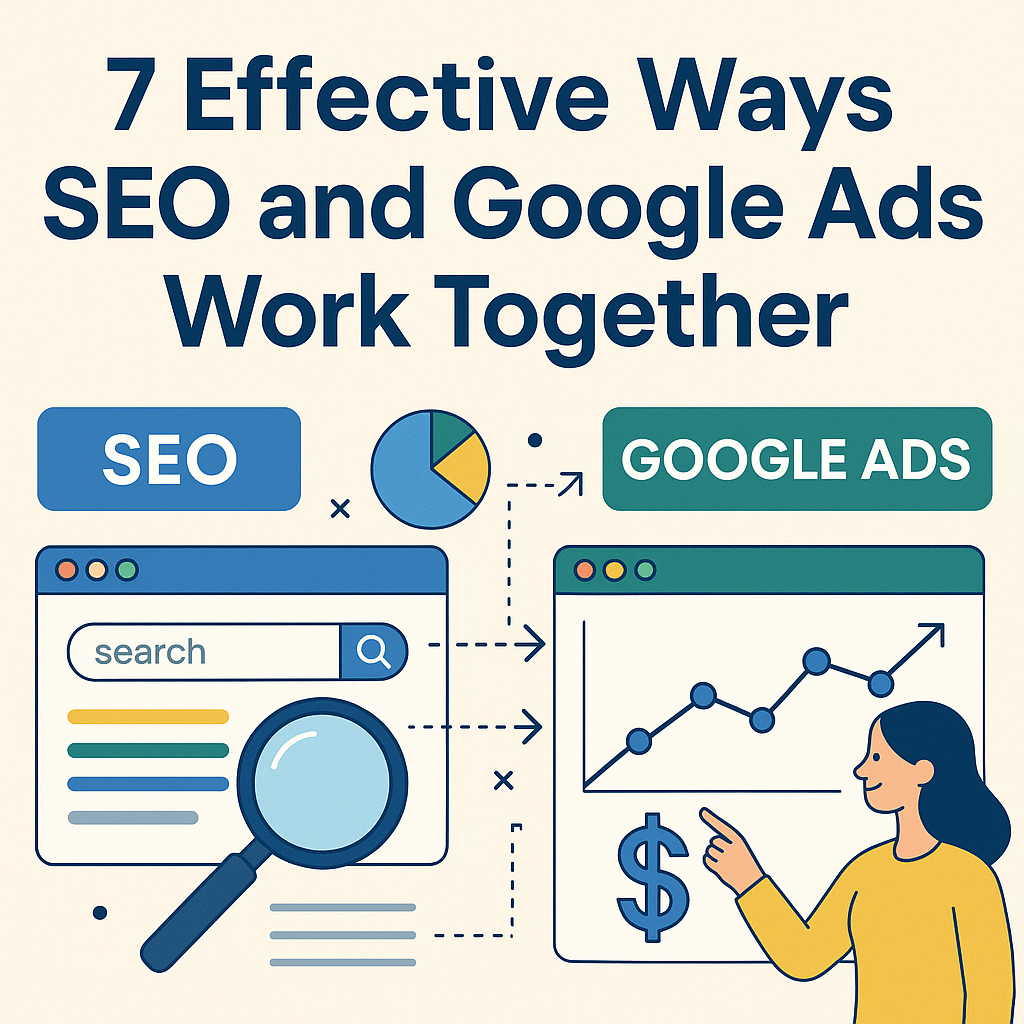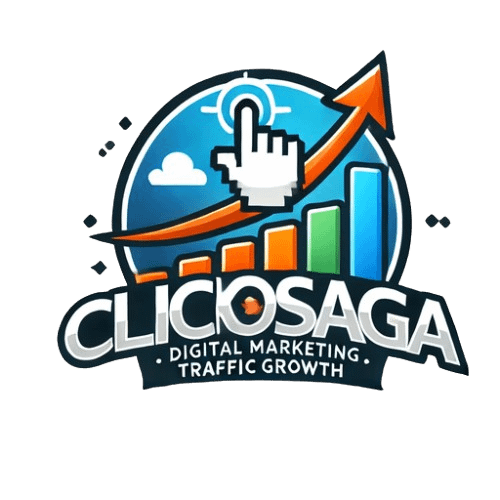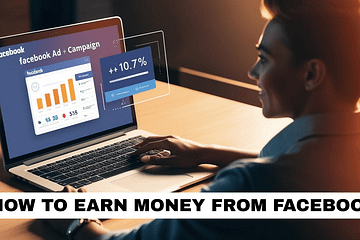Boost Visibility Using SEO and Google Ads
The way people find products online has changed, but search engines still lead the way. In 2025, businesses can’t rely on just one marketing method if they want to grow and succeed long-term.
Using multiple marketing channels works best SEO and Google Ads have become the backbone of any good online marketing plan. SEO helps your website show up naturally in search results, while Google Ads puts your business at the top of those same results – but you pay for the placement.
When you use SEO and Google Ads Work together, something special happens. They don’t compete – they actually make each other stronger. Your business becomes more visible online, you learn more about what your customers want, and you get more value from every dollar you spend on marketing.
The best part? This combined approach helps you reach customers at different stages of their buying journey, giving you more chances to make sales.
What Is SEO?

SEO stands for Search Engine Optimization. It’s the process of improving your website so it shows up higher in search results when people look for products or services like yours.
The four main parts of SEO are:
- Technical SEO: Making your website run smoothly – fast loading, mobile-friendly, and easy for search engines to find
- On-page SEO: Improving your content, page titles, headings, and links between pages to show what your site is about
- Off-page SEO: Getting other websites to link to yours and mention your brand to build your reputation
- Content strategy: Writing helpful information that answers questions and keeps visitors interested
When people find you through regular search results instead of ads, you gain their trust, don’t pay per click, and usually get visitors for a longer time.
What matters most for ranking in 2025:
- How people experience your website (speed, how it responds, stability)
- Content that thoroughly answers questions
- Websites that work well on phones
- Secure websites with SSL Certificates (HTTPS)
- Quality links from respected sites
- Showing you know what you’re talking about and can be trusted
When will you see results? It varies. Your competition, how established your website is, and your content quality all matter. Most businesses see small improvements in 3-6 months, with bigger results taking 6-12 months or more in competitive fields.
What Is Google Ads?

Google Ads (rebranded from AdWords in 2018) is Google’s paid advertising platform where businesses bid to display brief advertisements, service offerings, product listings, or videos to web users. It operates on a pay-per-click (PPC) model, meaning you only pay when someone clicks on your ad.
The evolution from AdWords to Google Ads brought a more comprehensive advertising ecosystem with expanded capabilities beyond simple text ads. The platform now encompasses multiple campaign types:
- Search campaigns: Text ads appearing in search results
- Display campaigns: Visual ads on websites throughout the Google Display Network
- Shopping campaigns: Product listings with images appearing in search results
- Video campaigns: Video advertisements shown on YouTube and partner sites
- App campaigns: Promotions for mobile applications across Google’s networks
- Performance Max: AI-driven campaigns that work across all Google ad inventory
Google Ads offers immediate visibility—your ads can appear at the top of search results from the moment your campaign launches. This immediate traffic potential makes it an invaluable tool for new websites, product launches, or time-sensitive promotions.
The Synergy Between SEO and Google Ads
The true power of search marketing emerges when SEO and Google Ads work together. Their synergy creates opportunities that neither channel alone can match:
Shared Data and Insights
Both channels generate valuable data about user behavior, keyword performance, and conversion patterns. When shared between teams, these insights inform more effective strategies:
- Google Ads conversion data helps prioritize high-value SEO targets
- SEO content performance informs ad copy and landing page optimization
- User behavior from both channels reveals deeper insights about the customer journey
Different Yet Complementary Conversion Paths
SEO and Google Ads often influence different parts of the customer journey:
- SEO typically excels at awareness and consideration stages through informational content
- Google Ads often drives conversions for users ready to purchase or take action
- Together, they create multiple touchpoints throughout the buying process
Coverage Across the Customer Journey
An integrated approach ensures visibility at every stage:
- Awareness: Display ads and informational organic content introduce your brand
- Consideration: Comparison content (both organic and paid) helps evaluation
- Decision: Shopping ads and product pages facilitate purchases
- Retention: Remarketing ads and resource content nurture relationships
Budget Optimization Opportunities
With proper attribution, businesses can allocate resources more effectively:
- Shift budget to Google Ads for keywords that are difficult to rank organically
- Reduce ad spend on keywords where you have strong organic performance
- Balance investments based on channel performance and customer acquisition cost
7 Effective Ways SEO and Google Ads Work Together

1. Keyword Research Sharing
One of the most immediate benefits of running both SEO and Google Ads is the wealth of keyword data generated across channels.
How Google Ads Data Informs SEO Keyword Strategy:
- Identify high-converting keywords from paid campaigns to prioritize for organic content
- Discover new keyword opportunities from Search Terms reports
- Evaluate keyword competition and conversion potential before committing to long-term SEO efforts
- Understand actual search volume and seasonal trends through impression data
Using SEO Performance to Refine Ads Campaigns:
- Identify high-performing organic keywords as candidates for paid amplification
- Reduce wasted ad spend by adding low-converting organic keywords as negative keywords
- Identify content gaps where organic performance is weak but paid performs well
- Recognize language patterns that resonate with your audience for improved ad copy
2. SERP Coverage Maximization
Appearing in both paid and organic results significantly increases your visibility and credibility.
Dominating Search Results with Both Paid and Organic Listings:
- Create a stronger brand impression by appearing multiple times on the same SERP
- Increase overall click-through rate (studies show appearing in both paid and organic results can lift total clicks by 25% or more)
- Recover traffic lost to organic ranking fluctuations with consistent paid presence
- Capture different segments of users (some prefer clicking organic results, others trust ads)
Strategies for Different SERP Features:
- Target featured snippets organically while bidding on the same terms
- Utilize Google Shopping for product-based businesses while optimizing product pages for organic visibility
- Leverage video content that can rank both organically and through video ad campaigns
- Implement structured data to earn rich results while using ad extensions for similar information
3. Remarketing to Organic Visitors
Organic traffic represents a valuable audience that has already shown interest in your content.
Using Google Ads to Reconnect with Organic Traffic:
- Create remarketing campaigns targeting users who found you through organic search
- Develop sequential messaging that builds on the content they already consumed
- Convert information-seeking organic visitors into customers through strategic ads
- Increase brand recall and consideration among past site visitors
Custom Audience Creation Strategies:
- Segment audiences based on which organic content they consumed
- Create lookalike audiences based on your best organic traffic converters
- Differentiate messaging based on engagement level with your organic content
- Exclude converters or highly engaged users to avoid unnecessary ad spend
4. Testing Content with Ads Before SEO Investment
Creating comprehensive SEO content requires significant investment. Google Ads offers a way to validate topics before committing resources.
A/B Testing Headlines and Messaging:
- Run ad variations with different messaging to identify what resonates best
- Test headline approaches before finalizing SEO-focused content titles
- Evaluate different value propositions to understand which drives the most engagement
- Discover language patterns that trigger higher click-through rates
Validating Content Topics Before Full Development:
- Create landing pages for potential content topics and drive traffic via ads
- Measure engagement metrics to determine which topics deserve full development
- Test different content formats (guides, tools, videos) before scaling production
- Identify audience segments most receptive to specific content themes
5. Using Ads to Supplement Difficult SEO Keywords
Some valuable keywords may be extremely challenging to rank for organically, especially for newer websites.
Competitive Niche Targeting:
- Identify high-value keywords with extreme organic competition
- Maintain visibility on important terms while building organic authority
- Target competitor brand terms through ads while building your organic alternative presence
- Analyze performance data to determine if the investment justifies continued competition
Supporting Seasonal or Trending Topics:
- Quickly capture seasonal traffic through ads while developing organic content
- Respond to trending topics immediately with ads while creating more comprehensive SEO content
- Maintain presence for cyclical terms year-round through ads when organic rankings fluctuate
- Test new market opportunities before committing to long-term SEO investments
6. Leveraging SEO Content in Ad Extensions
Your SEO content investments can enhance your Google Ads through strategic use of ad extensions.
Site Link Extensions:
- Link to your highest-performing organic content directly from ads
- Create a more robust ad presence with additional clickable elements
- Guide users to relevant supporting content that may help conversion
- Increase the total real estate your ad occupies on the SERP
Callout and Structured Snippet Opportunities:
- Repurpose key points from high-performing organic content as callout extensions
- Use category and feature information from your SEO taxonomy as structured snippets
- Highlight benefits and value propositions consistent with your organic messaging
- Reinforce brand positioning across both paid and organic touchpoints
7. Unified Analytics and Attribution
Understanding how both channels contribute to conversions is essential for proper optimization and budget allocation.
Cross-Channel Tracking Setup:
- Implement consistent tracking across both SEO and Google Ads
- Ensure Google Analytics and Google Ads are properly linked
- Set up goals and conversion tracking that capture all valuable actions
- Develop custom reports that show the relationship between channels
Understanding Assisted Conversions:
- Analyze multi-touch attribution models to see how channels work together
- Identify common paths where users interact with both organic and paid touchpoints
- Quantify the incremental value of running both channels simultaneously
- Recognize when paid search assists organic conversions and vice versa
Read Also – How Can Email Marketing Fuel Your Overall Inbound Strategy
Implementation Guide: Building Your Integrated Strategy
Implementing an integrated SEO and Google Ads approach requires careful planning and execution.
Audit of Current SEO and Google Ads Performance
Begin by understanding your current position:
- Evaluate organic visibility, rankings, and traffic patterns
- Assess Google Ads performance, quality scores, and conversion rates
- Identify overlaps and gaps between your paid and organic presence
- Benchmark your performance against competitors
Goal Setting and KPI Alignment
Develop unified objectives:
- Establish shared KPIs that both teams will work toward
- Align goals with overall business objectives
- Create reporting dashboards that show the complete search picture
- Set realistic timelines for different types of improvements
Budget Allocation Recommendations
Determine resource distribution:
- Allocate budget based on performance data and business priorities
- Create frameworks for shifting resources between channels as needed
- Develop models for calculating customer acquisition costs across channels
- Establish triggers for budget adjustments based on performance
Timeline for Implementation
Map out your integration process:
- Month 1-2: Audit, goal setting, and initial data sharing
- Month 2-3: Pilot integration projects and establish tracking
- Month 3-6: Full implementation of cross-channel strategies
- Month 6+: Optimization based on unified data and insights
Case Study: Success Story
A mid-sized e-commerce company specializing in home fitness equipment implemented an integrated SEO and Google Ads strategy with impressive results:
Challenge: The company had been running SEO and Google Ads separately, with different agencies managing each channel. Their teams rarely communicated, leading to duplicated efforts and inconsistent messaging.
Solution: They unified their search marketing under a single strategy with these key components:
- Shared keyword targeting based on performance data from both channels
- Content development informed by Google Ads conversion data
- Remarketing campaigns targeting their organic blog readers
- Unified attribution modeling to understand channel interactions
Results: After six months of implementation:
- 32% increase in overall search traffic
- 24% reduction in customer acquisition cost
- 47% improvement in conversion rate for organic traffic
- 18% higher ROAS (Return on Ad Spend)
The key lesson: The whole became greater than the sum of its parts when their search channels worked in concert rather than isolation.
Common Mistakes to Avoid
Siloed Teams and Data
When SEO and PPC teams operate independently:
- Valuable insights remain trapped within team boundaries
- Duplicate work wastes resources
- Opportunities for synergy go unrecognized
Solution: Implement regular cross-team meetings, shared dashboards, and collaborative planning sessions.
Inconsistent Messaging Across Channels
When your paid and organic presence communicate differently:
- Brand messaging becomes diluted
- User experience suffers from inconsistency
- Conversion rates decline due to disconnected journeys
Solution: Develop unified messaging guidelines and ensure all teams understand your core value propositions.
Over-Reliance on One Channel
When businesses favor either SEO or Google Ads exclusively:
- Vulnerability to algorithm updates or policy changes increases
- Opportunities for incremental gains are missed
- Customer journey touchpoints are limited
Solution: Maintain healthy investment in both channels, adjusting based on performance data rather than preference.
Misaligned Attribution Models
When conversion credit isn’t properly distributed:
- Channel value is miscalculated
- Budget decisions become skewed
- Team incentives may work against overall goals
Solution: Implement multi-touch attribution that recognizes both first-click and last-click contributions, as well as assisting interactions.
Conclusion
The integration of SEO and Google Ads represents one of the most powerful strategies in digital marketing. Rather than competing alternatives, these channels function as complementary forces that, when properly aligned, create a search presence greater than either could achieve alone.
By sharing data, coordinating messaging, and understanding how users interact with both paid and organic results, businesses can create more effective campaigns, allocate resources more efficiently, and ultimately drive stronger results.
The most successful digital marketers in 2025 recognize that the question isn’t “SEO or Google Ads?”—it’s “How can we maximize the synergy between SEO and Google Ads?”
Implementing the strategies outlined in this guide will help you build a more cohesive, data-driven search marketing approach that captures more traffic, converts more customers, and delivers superior ROI.
Begin by assessing your current integration level, identifying quick wins for improvement, and gradually building toward a fully unified search strategy. The competitive advantage of true integration will be well worth the effort.
FAQs About SEO and Google Ads Integration
1. Should I invest in SEO or Google Ads if I have a limited budget?
Even with limited resources, a balanced approach often yields the best results. Start with Google Ads for immediate traffic while building your SEO foundation. Allocate approximately 70% to the channel most aligned with your immediate business goals, but don’t neglect either completely.
2. How long does it take to see results from an integrated SEO and Google Ads strategy?
The benefits of data sharing and audience targeting can be seen almost immediately. Google Ads will drive instant traffic, while SEO improvements typically begin showing results within 3-6 months. Full integration benefits, including optimized attribution and maximal efficiency, usually manifest within 6-12 months.
3. Will running Google Ads improve my SEO rankings?
Google Ads does not directly influence organic rankings as a ranking factor. However, the data and insights gained from Google Ads can significantly improve your SEO strategy, leading to better content, targeting, and ultimately, improved rankings through more informed decisions.
4. How do I measure the success of my integrated search strategy?
Look beyond channel-specific metrics to holistic measurements like:
– Total search visibility percentage
– Blended customer acquisition cost
– Cross-channel conversion paths
– Overall search revenue and ROI
– Incremental lift when both channels run simultaneously
5. Should SEO and Google Ads be managed by the same team?
While not strictly necessary, having SEO and Google Ads under unified management—whether in-house or through an agency—typically produces better integration. If separate teams manage these channels, establish formal communication protocols, shared access to data, and aligned incentives.
6. How do I allocate budget between SEO and Google Ads?
Budget allocation should be dynamic, based on:
– Business objectives (growth vs. profitability)
– Current organic visibility
– Competitive landscape
– Seasonality and market conditions
– Historical performance data from both channels
– Most mature search strategies maintain ongoing investment in both, adjusting the ratio based on performance rather than eliminating either channel.
7. How can small businesses effectively leverage both SEO and Google Ads with limited resources?
Small businesses should:
– Focus on a narrow set of high-value keywords across both channels
– Use Google Ads to identify converting terms before investing in SEO content
– Leverage automation tools for basic optimization
– Consider platform-specific features like Local Service Ads and Google Business Profile
– Start with a concentrated geographic focus before expanding


![Is Digital Marketing a Pyramid Scheme? The Truth Finally Exposed [2025 Guide]](https://mladtschsizi.i.optimole.com/w:360/h:240/q:mauto/rt:fill/g:ce/ig:avif/https://clickosaga.com/wp-content/uploads/2025/03/61d657db-bf23-45a0-9b99-9d871c146d21.png)

